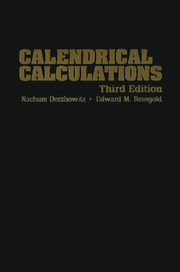Book contents
- Frontmatter
- Dedication
- Contents
- List of Frontispieces
- List of Figures
- List of Tables
- Abbreviations
- Mathematical Notations
- Preface
- Credits
- License and Limited Warranty and Remedy
- About the Cover
- 1 Calendar Basics
- I ARITHMETICAL CALENDARS
- II ASTRONOMICAL CALENDARS
- 13 Time and Astronomy
- 14 The Persian Calendar
- 15 The Bahá'í Calendar
- 16 The French Revolutionary Calendar
- 17 The Chinese Calendar
- 18 The Modern Hindu Calendars
- 19 The Tibetan Calendar
- 20 Astronomical Lunar Calendars
- Coda
- III APPENDICES
- Index
- Envoi
- About the Cover
18 - The Modern Hindu Calendars
Published online by Cambridge University Press: 05 February 2014
- Frontmatter
- Dedication
- Contents
- List of Frontispieces
- List of Figures
- List of Tables
- Abbreviations
- Mathematical Notations
- Preface
- Credits
- License and Limited Warranty and Remedy
- About the Cover
- 1 Calendar Basics
- I ARITHMETICAL CALENDARS
- II ASTRONOMICAL CALENDARS
- 13 Time and Astronomy
- 14 The Persian Calendar
- 15 The Bahá'í Calendar
- 16 The French Revolutionary Calendar
- 17 The Chinese Calendar
- 18 The Modern Hindu Calendars
- 19 The Tibetan Calendar
- 20 Astronomical Lunar Calendars
- Coda
- III APPENDICES
- Index
- Envoi
- About the Cover
Summary
From a chronological point of view the substitution for the mean calendric system of one based on the true movements of the sun and moon, was anything but an improvement, as it destabilized the foundations of the time reckoning. Indeed, the system may have had the charm of adapting daily life as nearly as the astronomical knowledge permitted to the movement of the heavenly bodies, but on the other hand it broke ties with history, as there was no unity of elements or systems. The very complexity of the system is proof of its primitiveness.
—W. E. van Wijk: Decimal Tables for the Reduction of Hindu Dates from the Data of the Sūrya-Siddhānta (1938)Today, numerous calendars are used in India for different purposes. The Gregorian calendar is used by the government for civil matters; the Islamic calendar is used by Moslems; the Hindus employ both solar and lunisolar calendars. Indeed, there are over 30 variations of the Hindu calendar in active use. In March 1957, an attempt was made to revise the traditional calendar to follow the pattern of the Gregorian leap year structure [1]. The proposed reform has not, however, been widely accepted, though the new, National Calendar dates appear in published calendars.
The best known of several related systems used on the Indian subcontinent is the classical Hindu calendar of the (Present) Sūrya-Siddhānta (circa 1000), said to have been revealed to Asura Maya the Assyrian at the end of the last ‘Golden Age,’ in the year 2,163,154 B.C.E.
- Type
- Chapter
- Information
- Calendrical Calculations , pp. 275 - 314Publisher: Cambridge University PressPrint publication year: 2007



